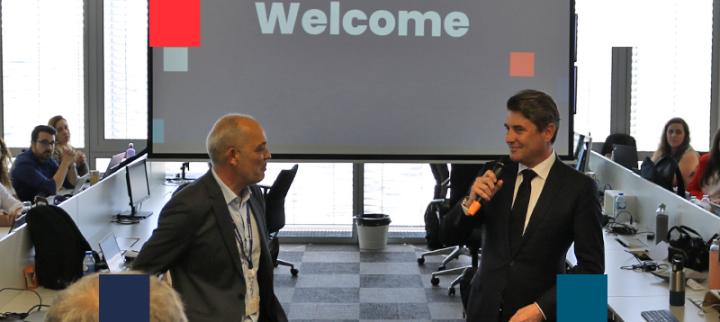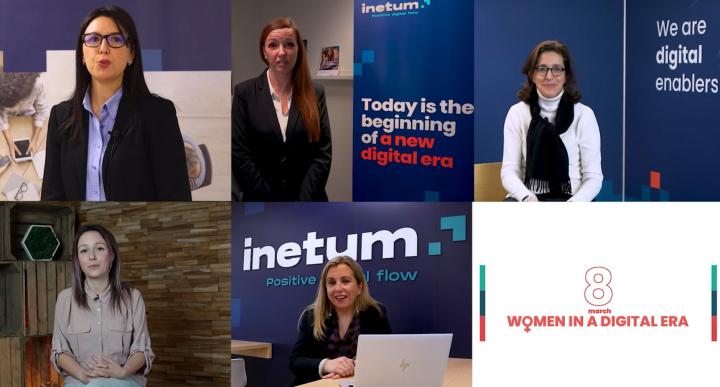Augmented reality that stands the test of business
Augmented reality that stands the test of business
Business Challenge #1
What will augmented reality look like in a professional environment in the years to come? What is the market situation and what are the ongoing projects to optimise technologies that are still in the development stages? Here is our analysis.
Creation date :
- Overview
A market about to explode
Google, Microsoft, Lenovo, Facebook, Apple... augmented reality technologies are currently keeping the research and development (R & D) departments of all the web giants busy. And according to estimates by the IDC market research company, the market seems to be about to explode: 24 million augmented reality products will be sold in 2021, compared with just 160,000 in 2016.
What is the reason for this increasing interest? It is the numerous possibilities this technology offers to companies: facilitating remote maintenance, ensuring the traceability of operations, optimising training, visualising the digital model of a building... the use cases are endless. Applications that are also an opportunity for companies to have a certain advantage over competitors who are still hesitant.
However, augmented reality still faces many technological challenges. How to improve user comfort? How to facilitate collaborative work in mixed reality environments? How to include an augmented reality headset within a larger digital ecosystem? For now, the first augmented reality headsets focus on consumer gaming applications. Therefore, they do not face these challenges directly.
- TAKING UP THE CHALLENGE
Combining innovations to adapt to different business activities
The researchers and engineers at the Inetum Informatique Lab are working on precisely these issues. What is their first challenge? To design an augmented reality headset that can adapt to many use cases. To achieve this, Inetum Informatique has chosen "video see-through" technology, which, as opposed to "optical see-through", reproduces the environment filmed before the eyes of the user, on the screen of the headset. It is an approach that opens up more opportunities and on which the start-up company, Process SL, is working in partnership with Inetum Informatique. To sum up, SL Process is developing an augmented reality headset called PARA as well as its operating system, while the Inetum Informatique team is working on vertical solutions.
Their first exploit was to make the headset wearable. The device requires exceptional computing power that usually only a high-performance PC can provide. Thanks to their work on the optimisation of algorithms and the intelligent distribution of processing, the team has managed to make the set autonomous and usable on the move.
But the work does not stop there. To optimise the restitution of the environment and the interactions with the user, the Lab engineers use Simultaneous Location and Mapping (SLAM) technology. These are algorithms that aim to situate the user in space and to reconstitute the environment in 3D in a very precise way. The challenge is significant as it involves performing both operations in real time. In this context, the experts at SL Process and Inetum Informatique mix "computer vision" technologies with those also used in robotics, as is done for autonomous vehicles. With one difference, as the augmented reality helmet can only include a limited number of sensors, due to its size and its battery autonomy. To function, it relies mainly on its cameras as well as minimalist, but high-precision sensors such as accelerometers and gyroscopes. The challenge is to create algorithms that are accurate enough to deduct the position and movements of the user, from this minimal information. Lidar lasers could also make an appearance along with other sensors such as matrix mics to adapt to new uses. The headset also includes an infrared sensor to accurately detect the movement of the user's hands.
Another challenge: to improve the comfort of the user. With this in mind, Inetum Informatique and SL Process researchers rely on "eye-tracking”. Thanks to this system, the information is placed directly where the user turns their gaze. Similarly, the "eye-tracking "helps strengthen the real feeling of a virtual scene by recreating blur generated naturally by the brain in a real environment. Equally to improve the comfort and the relevance of the information, the experts optimise the contextualisation of feedback data. For example, a maintenance agent is working on a site in difficult weather conditions? The headset automatically simplifies the interface to facilitate their job. There are many ambitious projects to create innovative use in companies.
- The Expert Voice
Combining technologies
"To innovate, especially in augmented reality, there is no question of reasoning in silos. To implement new use cases, Inetum is working on a set of technological building-blocks: SLAM, eye-tracking, computer vision and artificial intelligence, robotics, and even drones, which will make it possible to go even further in augmented reality".
Jean-François Gaudy, Chief Innovation Officer, Inetum
- Inetum accompanies you
Discover our FabLab to turn your ideas into augmented reality!
Are you interested in the possibilities offered by augmented reality? Do you want to find out more and see our projects? Discover our FabLab dedicated to innovation!


